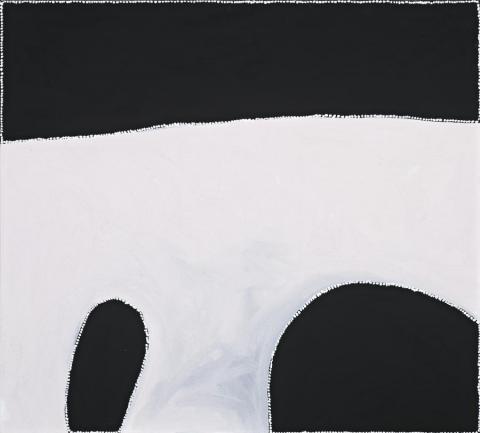JACK AMBLE BORE, 2004
Paddy Bedford
natural earth pigments on linen
122.0 x 135.0 cm
inscribed verso: title, Jirrawun Arts cat. PB6-2004-183
Jirrawun Arts, Kununurra
Private collection, Adelaide
Storer, R., Paddy Bedford, Museum of Contemporary Art, Sydney, 2006, p.154 (illus.)
Jack Amble Bore, in Storer, R., Paddy Bedford, Museum of Contemporary Art, Sydney, 2006, p.161 (illus.), cat. PB CB–2004.24. This is the only other recorded painting of this site by the artist.
Sir William Dean in his eulogy to Paddy Bedford in September 2007, recalled that Bedford was a man of ‘great dignity and spiritual strength... a much loved senior Elder and lawman who late in the story of his life discovered a rare artistic genius that resulted in him being recognised as one of the great painters of our continent.'1
In 1997 Nyunkuny, commonly known by his nickname ‘Kuwumji' and also by his ‘gardiya' name Paddy Bedford, started painting his stories on board and canvas. A Gija lawman of Jawalyi skin, Bedford, an important traditional elder of high regard, produced works of a remarkable authority and confidence. The rest is legend, within several years Bedford acquired a reputation for not only inheriting the legacy of Rover Thomas but of pushing new boundaries with his famously fluent “walking line”. Steeped in traditional law and the Ngarranggarrni (Gija dreaming) he drew on a seemingly endless source of traditional lore and knowledge of significant sites. His paintings combine important family Dreamings such as Garnanganyjen (Emu), Birnkirrbal (Bush Turkey) and Ngayilanji (White Cockatoo) with the physical world of roads, rivers, traditional life, stock camp life, stock yards and country visited whilst mustering.
Catalogued as painting PB6–2004–183 in Bedford's chronological index of works, this painting on linen was executed in 2004 and represents the country of Jack Amble Bore, Langaban, in his mother and uncles's country. Located south–east of Bedford Downs and just south of the Ord river with the Springvale - Landsdowne road passing close by, Jack Amble Bore is the dreaming place for a kind of fungus known as puff ball fungus which grows abundantly there. There are lots of little caves here, linked together by bush tracks. Today there is also a bore with a windmill also called Jack Amble Bore.
Stylistically, Jack Amble Bore characterises Bedford's later painting where he has moved away from the manner of the earlier east Kimberley painters to create his own representations of country. In this painting, large black voluminous forms are outlined by white dots, enveloped by a wash of white with a subtle blush of pink. As with his other later works where the use of colour has evolved to incorporate softer, more delicate hues of reds, blues and pinks, this painting, as Patrick Hutchings elaborates, is ‘as sparse and eloquent as a Miro, it is heightened rather than softened by the delicate pinks painted wet into wet, which recall the rose brulee of Kimberley rocks.'2
In 2006, in recognition of his outstanding contribution to Australian culture he was honoured by a major retrospective at the Museum of Contemporary Art, Sydney. He was also one of the handful of Aboriginal artists commissioned to contribute to the permanent collection of the Musée du quai Branly, Paris. Since his death in 2007 at the age of 85 his paintings have continued to be keenly sought after as the significance and quality of his astonishing body of work becomes increasingly evident.
1. Dean, Sir William,‘Eulogy for Old Man,' in Paddy Bedford; Bury My Heart at Bow River, exhibition catalogue, William Mora Galleries, Melbourne, 2009, p. 14
2. Hutchings, P.,‘Of Land Spirit and Freedom, The Age, Melbourne, 11 June 2005
